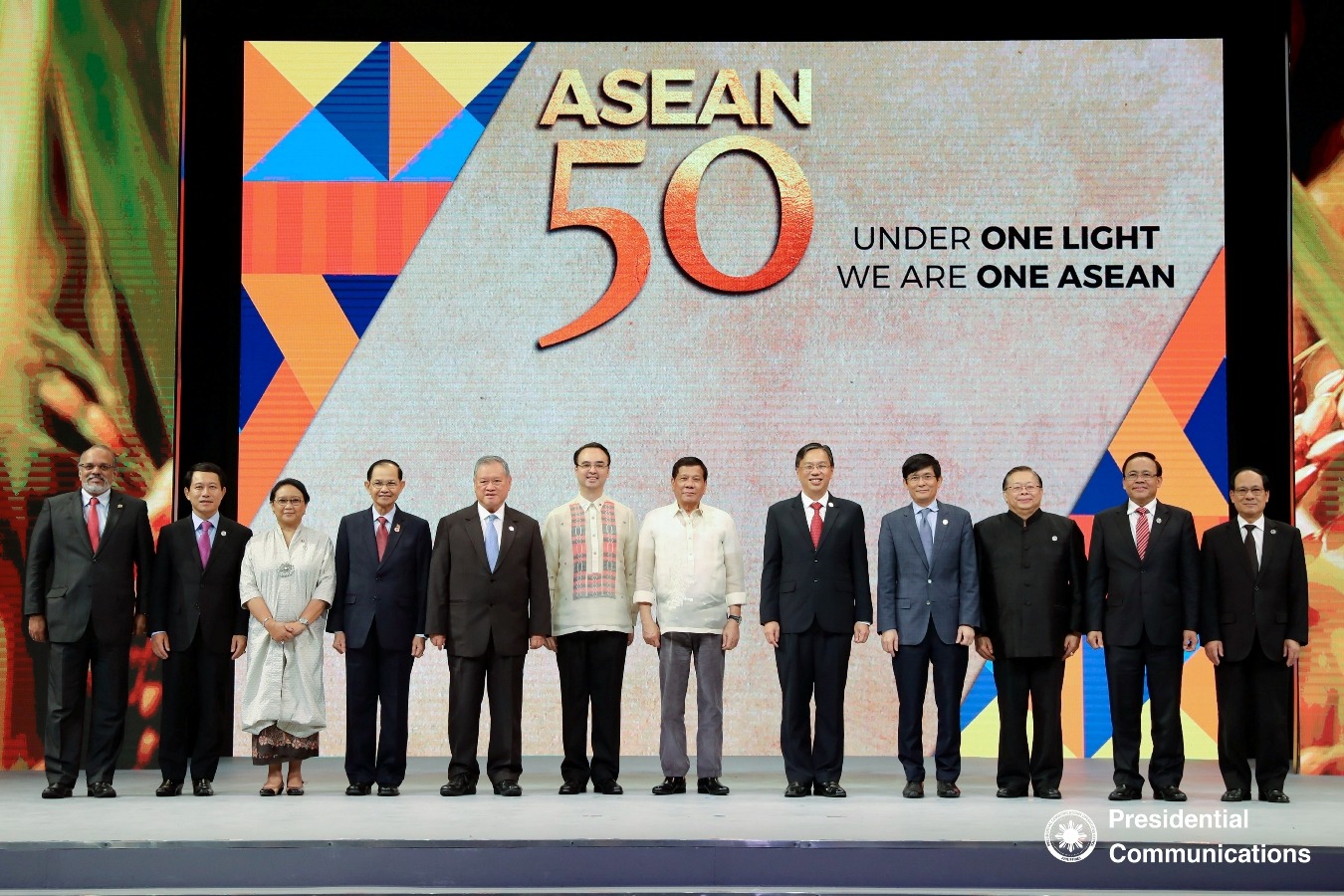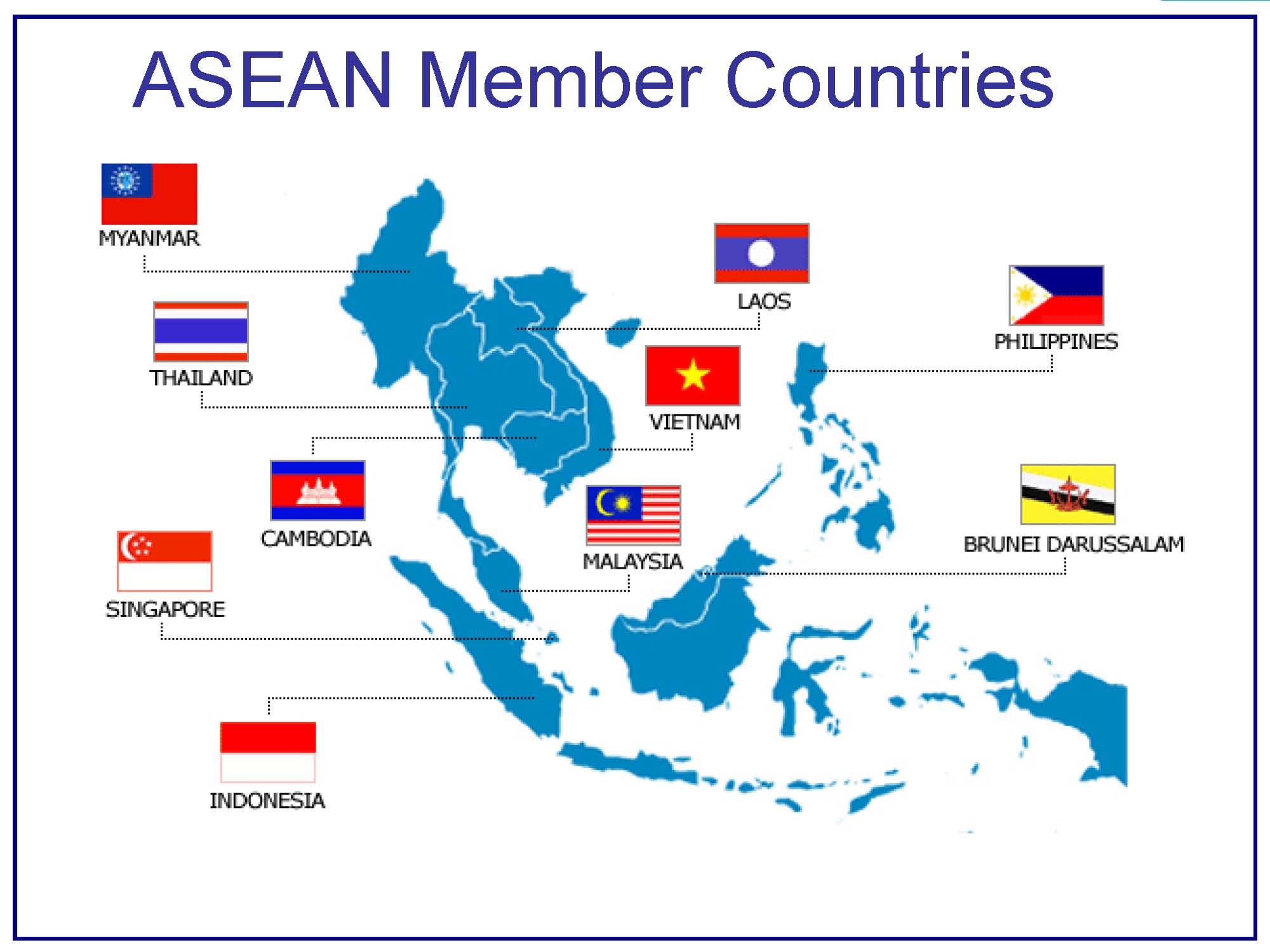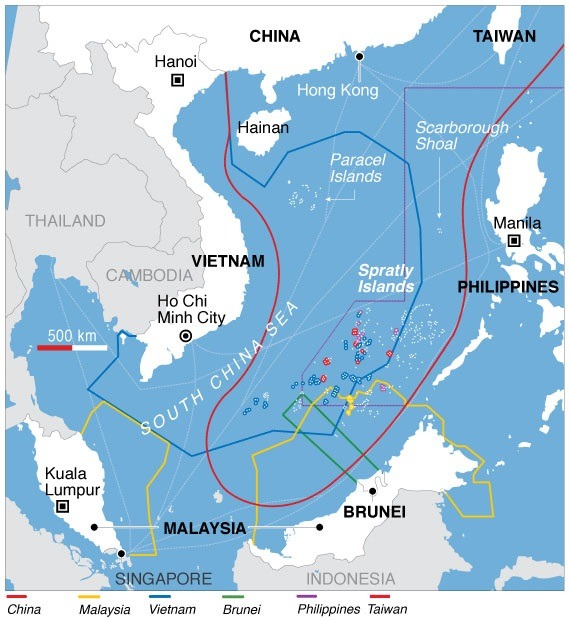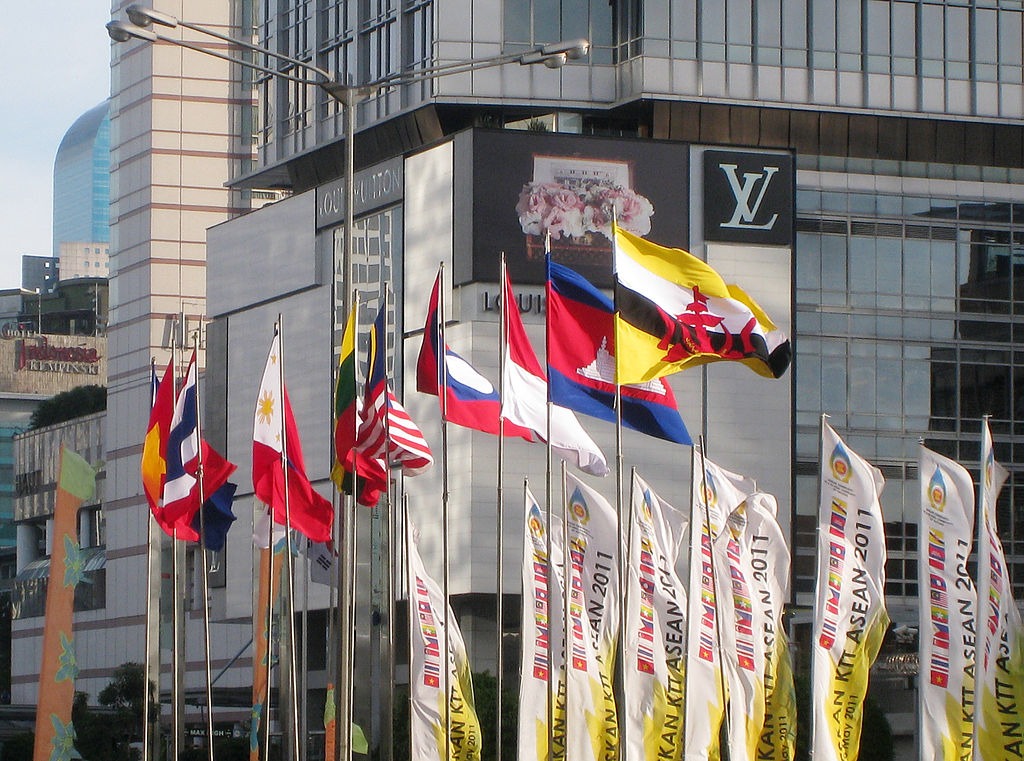What’s ASEAN Good For?

By Shruti Kothari
Staff Writer
9/3/2020

Rodrigo Duterte with foreign ministers of various ASEAN member states during the group’s 50th anniversary, August 2017
In 1967, the Association of Southeast Asian Nations (ASEAN) was born. In a bid to reduce intra-regional disputes and mitigate external shocks, Thailand, Malaysia, Indonesia, the Philippines, and Singapore formed a partnership. Given the diversity of the nations religiously, culturally, and geographically, its fundamental tenet was a Westphalian principle of non-interference forbidding members from infringing each other’s sovereignty or interfering in each other’s domestic affairs. Its aims were regional stability, peace, security, and prosperity, all to be achieved through cooperation and diplomacy, and it came to decisions by consensus. Its strength was neighborly goodwill.
When Vietnam and Cambodia got involved in a conflict in 1978, the UN and the ASEAN worked together to settle it at the 1991 Paris Peace Accords. Brunei, Laos, Vietnam, Cambodia, and Myanmar all joined the association before the turn of the millennium, and now East Timor is the only Southeast Asian country not in the ASEAN.

Rather than face issues head-on, the general approach is to cultivate conditions of peace and prosperity through things like beneficial economic agreements such as the establishment of AFTA (the ASEAN Free Trade Agreement), and an emphasis on development, rather than conflict management. Most conflicts, like the displacement of various ethnic minorities including Karen groups in Myanmar, simply fizzle out over time. Moreover, the non-interference tenet also stops member nations from supporting insurgencies in other countries, a practice which was not uncommon before the conception of the ASEAN.
The ASEAN also responds to non-traditional security issues, like natural disasters, environmental hazards, epidemics, and transnational crime. Subcommittees like the ASEAN Committee on Disaster Management (ACDM) spearhead these efforts. While they do not offer significant financial aid, they provide technical assistance, volunteer programs, and diplomatic engagement. For example, after Myanmar’s devastating Cyclone Nargis hit in 2008, the ASEAN was central in breaking the deadlock between the government of Myanmar, and outside parties looking to provide aid. It mediated between the isolationist nation and groups like the UN, even creating the Tripartite Core Group (TCG), so that all parties could overcome mistrust and allow humanitarian access to affected areas for two years.
There were other times when the association’s role has been instrumental. For example, during the violent clashes between Thailand and Cambodia in 2011, the ASEAN, under Indonesia’s energetic chairmanship, and in conjunction with the UN and the ICJ, observed the creation of a demilitarized zone and monitored troop withdrawal with the consent of all involved parties. This was an unusually proactive step for the ASEAN, however, and the International Crisis Group, credits Indonesia’s chairmanship for this more than anything else. As chairmanship of the ASEAN rotates annually between all member states, this change in attitude was fleeting.
Although open conflict between member states decreased dramatically since the association’s conception, there is much debate on how much the ASEAN has contributed to this. Certainly, even from the outset, the conclusion of the Vietnam War, the decline of Communism, and bilateral agreements between member states independent of the ASEAN all inarguably played vital roles.
Certain agreements like the 1976 Treaty of Amity and Cooperation in Southeast Asia, which call for peaceful settlements through regional processes, and the 1995 Treaty of Southeast Asia Nuclear Weapons-Free Zone, which discourages the proliferation of nuclear weapons, attempt to tackle security issues. However, these are more guidelines than rules, as there is no real way to enforce compliance due to the non-interference principle.
There is no real way to enforce compliance with ASEAN agreements due to the non-interference principle.
The non-interference principle also prevents the ASEAN from curbing human rights violations by its members. During the 2015 Rohingya crisis in the Rakhine state of Myanmar, condemned internationally as ethnic cleansing, the ASEAN made no comment, despite stipulated human rights commitments in its Human Rights Declaration. In 2019, the Philippine drug war saw the Armed Conflict Location and Event Data Project (ACLED) label the country “one of the deadliest places in the world to be a civilian,” due to the prevalence of extra-judicial killings. President Rodrigo Duterte appeared before ASEAN representatives and denied the claims, they had no authority to investigate, and so that was the end of the matter.

Rohingya refugees
Another weakness is (extant) internal disputes, which prevent real trust between member nations and circumscribes the ASEAN’s capacity to act as a united bloc. Maritime disputes in the South China Sea are a prime example. The Spratly Islands, rich in fishing grounds, oil, and natural gas, and located along important shipping routes, are claimed by the Philippines, Vietnam, Brunei, Malaysia, Taiwan, and China, with strategic military positioning backing the claims of each.
The ASEAN has made no real headway in solving this issue. While some, like former ASEAN Secretary General Rodolfo Severino, argue that the association has served to hold violence at bay through various codes of conduct and agreements on friendly and diplomatic behavior by concerned parties, the disputes are at a delicate stalemate rather than settled. It is questionable how long the status quo, already fractured, will hold.
Disputes within ASEAN are at a delicate stalemate rather than settled.
In recent years, China has grown more aggressive. It has been building islands on disputed reefs, despite a recent ruling by the Permanent Court of Arbitration (PCA) in The Hague declaring that it has no historic claims to the area. Ideally, a peaceful solution will be reached, negotiated solely by the nations that have recognized historic claims in the area. However, it would take a united ASEAN (which may not be realistic) to exclude China and achieve such an outcome.

South China Sea claims
While the ASEAN helped cultivate international recognition for the region independent of India and China, a lack of true cohesion has consistently prevented it from being a formidable force in the face of external pressures. It is a far cry from its slogan of “One Vision, One Identity, One Community.” The very principle of non-interference makes it difficult to develop a shared identity. At the same time, some ASEAN members have become so dependent on Chinese investment that Donald Emmerson, Director of the Southeast Asia Program at Stanford University, warned that “[i]n the future, we may be looking at the relative absorption of Myanmar, Laos, and Cambodia into China.” As its investment in the region grows, so does China’s influence.
Moreover, on the ground level, ASEAN has limited relevance. Emmerson explained that “the way people live their lives is very far removed from the ASEAN. If you conducted a survey of the 640 million people in Southeast Asia, how many would have an answer to the question, ‘What is the ASEAN?’ It is a superficial, elite-level, diplomatic convenience with very little resonance.”

Flags of various ASEAN member states (Picture Credit: Gunawan Kartapranata)
The extent of this was exposed during the 2015 implementation of the ASEAN Economic Community (AEC), which was supposed to step up the integration between countries through measures like the free flow of goods, services, capital, and skilled labor to boost the regional economy. However, due to language barriers, cultural differences, weak governance, and lack of awareness of the AEC, there was very little discernible change in the market.
We can compare this to a bloc like the European Union, where information is easily available to citizens, there is more similarity in culture and language, and more similarities in religion and political systems. These factors make dissolving borders and surrendering some political autonomy easier. Despite the fact that the EU was formed less than 30 years ago, it has successfully adopted common goals, a common currency, shared education programs, free movement of citizens within its bounds, not just for travel but also for work. It’s able to leverage its unity in dealing with other countries. It has become a world power, awarded a Nobel Prize for creating a European Community tight enough to prevent war. A key reason for this unity is the existence of EU bodies like the European Parliament, which has the ability to penalize non-complying members through formal court procedures at the European Court of Justice, which can impose punishments like financial penalties, or suspension of voting rights, as Poland experienced in 2017 for undermining democracy.
This is something ASEAN doesn’t have. There have been attempts to improve this, with, for example, the adoption of a progressive human rights framework, but the efficacy of a non-legally binding guideline seems dubious, given how its members have struggled to even comply with human rights commitments stipulated in the ASEAN’s own charter as well as in the ASEAN Human Rights Declaration.
Within the limitations of the non-interference principle, the ASEAN should build on its successes in non-contentious areas like aid in the event of natural disasters. It should also focus on mitigating climate change and transboundary haze. The ASEAN Vision 2020 details some excellent goals, like accelerating the development of science and technology by establishing a regional technology network; forging agreements in energy and utilities to promote energy efficiency and develop renewable resources; enhancing food security; developing regional infrastructure; and maintaining regional macroeconomic stability.
However, if the ASEAN truly wants to become a power to contend with, and to be able to assert itself against China’s growing might, it will have to make fundamental changes to its modus operandi. Member states will need to prioritize long-term regional interests over their own short-term ones. It would have to abandon its non-interference principle that prevents the penalizing of errant members. Its consensus-based decision-making would also have to be replaced, perhaps by a central body with proportional representation from each member, with decisions reached by majority vote, as with the European Parliament.
Unity like that in the EU is achievable, but the ASEAN would have to rewrite its charter and essentially re-forge itself on a radically different foundation. This could only happen if member states felt threatened enough to see that sacrificing a degree of autonomy to bind themselves together is preferable to having their autonomy eroded by China and once again becoming the afterthoughts of a more powerful civilization.
